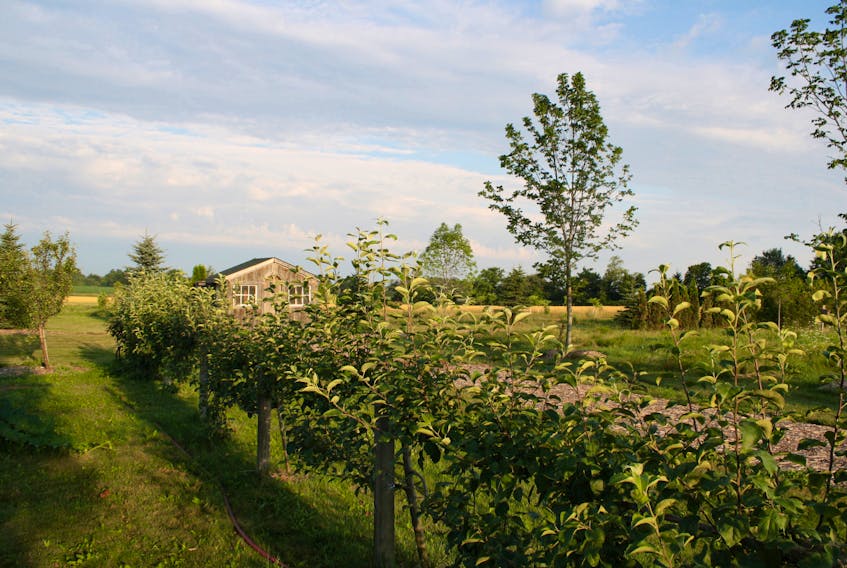Ben was ‘an artist without a canvas’ – a passion for food, and nowhere to plant.
When he graduated from the Ridgetown Agriculture College there was one thing that set him apart from most of his classmates: he was not leaving school to return to the family farm.
The last few years, Ben has enjoyed container gardening, indoor plants and gardening in small urban yards. This spring, everything changes; now that he has secured a 1,000 square-foot plot 10 minutes from his home in Guelph, Ont.
For Mark, this season will be business as usual – growing loads of vegetables in his one-acre veggie garden, in addition to the remaining nine or so acres of orchards, meadows and flowers.
Two artists, two canvasses. How will we work differently? What can you learn from this?
Ben:
My 1,000 square feet is a big allotment, but my ambitions started out on a much larger scale, so I want to maximize space.
- “Square foot gardening”. Square Foot gardening was pioneered by Mel Bartholomew, an engineer who applied his mechanical inclinations to vegetable gardening. I am employing this concept in about one quarter of my allotment. Using string to outline a grid of one square foot sections. Planning becomes easy: in each square I will plant 16 carrots, nine onions, four Swiss chard or one broccoli, and so on. This allows for maximum density, and it is easy to plan, organize and maintain. http://www.squarefootgardening.com/
- Intercropping works very well with certain crops, which I intend to grow elsewhere in the allotment. Two or more plants will be planted in the same space, which will benefit one another mutually. The most popular example is what Native Americans called the “Three Sisters” – planting sweet corn in a block, with climbing beans interspersed, and squash spreading across the ground below. The ‘sisters’ evidently get along very well. The corn provides structure for the beans, and the beans fix nitrogen from the air to feed the corn, while the big leaves of the squash suppress weeds and keep the soil moist.
- Herbal tea is a heavily consumed item in my household, and as a crop it keeps well once dried. Mint and chamomile are easy to grow and are two of our favourites. The process is simple – harvest the chamomile flower and the Mint leaves, and hang them to dry or process them through a dehydrator. Bingo.
- A “pollinator’s perimeter” will provide an easy and attractive border, in addition to attracting and sustaining the necessary pollinators to the garden. The easiest way to establish this is to find a bee and pollinator wildflower seed mix, which will contain a blend of black eyed Susan, borage officinalis, butterfly weed, corn poppy, blanket flower, coreopsis, New England aster, wild lupins, coneflowers, and wild bergamot.
Mark:
While I have the luxury of space on 10 acres, I also have the luxury of 13 years’ experience on the property and a few more years growing at three previous homes.
- Perennial crops are well established. I constructed a wire system to support a very healthy and bountiful raspberry crop that comes back year after year. The apple orchard on the West side of the garden is also coming to maturity, with 50 trees. Two years ago, I harvested several bushels of fresh apples.
- Parallel to the vegetable garden on the northern edge runs an “apple fence”, inspired by Claude Monet’s garden in Giverny, France. It was important to create space for the veggie garden that is visually separate from the rest of the farm. This fence was created by growing dwarf apple trees, trained along two horizontal wires and delineates the vegetable garden from the rest of the property. A nice harvest from my Monet apple fence each season.
- Crops are rotated throughout the beds to maximize soil fertility and suppress weed and disease pressure. For example, I avoid planting tomatoes after potatoes or peppers, as late blight can overwinter in potatoes and kill the tomatoes. However, planting tomatoes after a legume, such as beans, is beneficial, as the beans will leave the soil enriched by fixing nitrogen out of the atmosphere for the tomato plant’s consumption.
Indeed, every artist needs their canvas. Now, as Monet plotted his garden in Giverny, we are off to the drawing board to finish plotting our gardens for 2018.
Mark Cullen is an expert gardener, author, broadcaster, tree advocate and holds the Order of Canada. His son Ben is a fourth-generation urban gardener and graduate of University of Guelph and Dalhousie University in Halifax. Follow them at markcullen.com, @markcullengardening, on Facebook and bi-weekly on Global TV’s “National Morning Show.”









